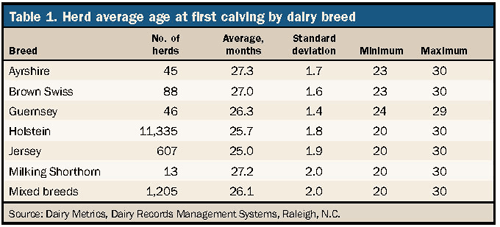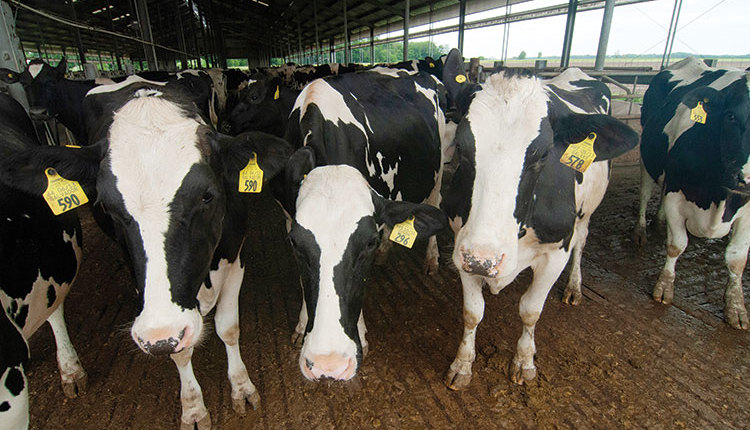The author is a professor of animal sciences at Kansas State University, Manhattan.
Heifers are not only the most fertile group of females on your dairy, they generally represent the best genetics. Despite these positive attributes, too many dairies don't take full advantage of this valuable resource because too many heifers are not inseminated when they have reached adequate age, stature, and body weight. The statistics confirm progress has been slow as age at first calving has dropped slightly from the 28 to 30 months of age during the past 20 years.
That begs the question, where is the industry headed towards increasing the efficiency of heifer breeding? More importantly, what is the age of your replacements at first calving? Whether you manage your own replacements or have them reared by someone else, you should monitor this important economic trait.
Age at first calving
Recent research on some 13,000 dairy farms confirms age at first calving ranges from 25 to 27.3 months as shown in Table 1. Minimum and maximum values by breed also are shown. Clearly, most herds could better manage their heifers. The records for this study come from Dairy Records Management Systems in Raleigh, N.C. It was edited to remove herds in which age at first calving was obviously not recorded accurately on the farm (such as herds with average age at first calving less than 20 months and older than 30 months).

Because approximately 90 percent of DHIA herds consist of Holsteins, I summarized some other important economic characteristics of Holstein herds according to the average age of their heifers at first calving (Table 2). Note that for every characteristic summarized, dairy producers who calved their heifers at younger ages had cows that excelled in milk, fat, and protein yield and in pregnancy rate.

Can we say that because heifers calved at younger ages that the variables in Table 2 were improved? Probably not. Although this may not be a cause and effect relationship, it is clear that these management traits are likely highly correlated.
In older studies, evidence indicated that heifers that calved at older ages produced more milk in their first lactation, but when lifetime yields were calculated, heifers calving at younger ages produced more lifetime milk. When lifetime yields were expressed as milk per day of herd life, heifers calving at younger ages led the way. Dairy heifers are an asset whose value cannot be tapped until they freshen and begin to produce a salable product - milk.
Optimal age at first calving
To maximize lactation performance and reduce rearing costs, a general recommendation is that average age at first calving in Holsteins be around 24 months with body weights greater than 1,230 pounds after calving at 24 months. A retrospective study of age at first calving of Holstein dairy heifers was conducted in three California commercial dairy herds (J. Dairy Sci. 87:2730; 2004). Heifers (n = 1,905) were moved to breeding pens between 12 and 13 months of age and grouped retrospectively according to age at first calving as low (around 23 months), medium (23 to 24.5 months), and high (around 24.5 months).
Within herds, all heifers were managed similarly before first calving. Heifers were fed to gain 1.5 to 1.8 pounds per day from 4 months of age until breeding, and 1.8 to 2.0 pounds per day from breeding to 252 to 258 days of pregnancy.
Once calving occurred, first-lactation cows were fed the same diet until 310 days in milk (DIM). First calving at less than 23 months compromised first-lactation yields of milk and milk components and impaired reproductive performance. In contrast, extending age at first calving beyond 25 months did not improve production, reproduction, or health of first-lactation cows. Although not preassigned to age groups before start of breeding, Holstein heifers managed as in this study had the greatest economic returns (between $99 and $138 per heifer) when calving between 23 and 24.5 months of age.
Getting them bred
To reduce age at first calving, in many cases, most veterinary practitioners and fresh cow managers find that it is as simple as applying more aggressive breeding pen management. This includes incorporating a single injection of prostaglandin when heifers are moved into the A.I. breeding pens. Some of the best results we have achieved in our research were accomplished by administering prostaglandin and then watching for heat - inseminating those detected in heat according to the a.m.-p.m. rule - and then treating all noninseminated heifers 14 days after the first prostaglandin before another round of good heat detection. Fertility in well-grown dairy heifers should be in the 60 percentage range when good heat detection is matched with competent inseminating technique. Results will be less, however, when using sexed or gender-biased semen.
Heifers that get off to a good start and are fed according to the National Research Council (NRC) standard guidelines should be developed well enough to begin A.I. breeding by 12 to 13 months of age. A heifer cannot calve by 2 years or 24 months of age unless she conceives by 15 months of age. Timely breeding management of dairy heifers will result in younger age at first calving and more lifetime milk production. Maybe this should a topic of discussion at your next management team meeting. Happy A.I. Breeding!
Click here to return to the Calf & Heifer E-Sources
110310_168
Heifers are not only the most fertile group of females on your dairy, they generally represent the best genetics. Despite these positive attributes, too many dairies don't take full advantage of this valuable resource because too many heifers are not inseminated when they have reached adequate age, stature, and body weight. The statistics confirm progress has been slow as age at first calving has dropped slightly from the 28 to 30 months of age during the past 20 years.
That begs the question, where is the industry headed towards increasing the efficiency of heifer breeding? More importantly, what is the age of your replacements at first calving? Whether you manage your own replacements or have them reared by someone else, you should monitor this important economic trait.
Age at first calving
Recent research on some 13,000 dairy farms confirms age at first calving ranges from 25 to 27.3 months as shown in Table 1. Minimum and maximum values by breed also are shown. Clearly, most herds could better manage their heifers. The records for this study come from Dairy Records Management Systems in Raleigh, N.C. It was edited to remove herds in which age at first calving was obviously not recorded accurately on the farm (such as herds with average age at first calving less than 20 months and older than 30 months).

Because approximately 90 percent of DHIA herds consist of Holsteins, I summarized some other important economic characteristics of Holstein herds according to the average age of their heifers at first calving (Table 2). Note that for every characteristic summarized, dairy producers who calved their heifers at younger ages had cows that excelled in milk, fat, and protein yield and in pregnancy rate.

Can we say that because heifers calved at younger ages that the variables in Table 2 were improved? Probably not. Although this may not be a cause and effect relationship, it is clear that these management traits are likely highly correlated.
In older studies, evidence indicated that heifers that calved at older ages produced more milk in their first lactation, but when lifetime yields were calculated, heifers calving at younger ages produced more lifetime milk. When lifetime yields were expressed as milk per day of herd life, heifers calving at younger ages led the way. Dairy heifers are an asset whose value cannot be tapped until they freshen and begin to produce a salable product - milk.
Optimal age at first calving
To maximize lactation performance and reduce rearing costs, a general recommendation is that average age at first calving in Holsteins be around 24 months with body weights greater than 1,230 pounds after calving at 24 months. A retrospective study of age at first calving of Holstein dairy heifers was conducted in three California commercial dairy herds (J. Dairy Sci. 87:2730; 2004). Heifers (n = 1,905) were moved to breeding pens between 12 and 13 months of age and grouped retrospectively according to age at first calving as low (around 23 months), medium (23 to 24.5 months), and high (around 24.5 months).
Within herds, all heifers were managed similarly before first calving. Heifers were fed to gain 1.5 to 1.8 pounds per day from 4 months of age until breeding, and 1.8 to 2.0 pounds per day from breeding to 252 to 258 days of pregnancy.
Once calving occurred, first-lactation cows were fed the same diet until 310 days in milk (DIM). First calving at less than 23 months compromised first-lactation yields of milk and milk components and impaired reproductive performance. In contrast, extending age at first calving beyond 25 months did not improve production, reproduction, or health of first-lactation cows. Although not preassigned to age groups before start of breeding, Holstein heifers managed as in this study had the greatest economic returns (between $99 and $138 per heifer) when calving between 23 and 24.5 months of age.
Getting them bred
To reduce age at first calving, in many cases, most veterinary practitioners and fresh cow managers find that it is as simple as applying more aggressive breeding pen management. This includes incorporating a single injection of prostaglandin when heifers are moved into the A.I. breeding pens. Some of the best results we have achieved in our research were accomplished by administering prostaglandin and then watching for heat - inseminating those detected in heat according to the a.m.-p.m. rule - and then treating all noninseminated heifers 14 days after the first prostaglandin before another round of good heat detection. Fertility in well-grown dairy heifers should be in the 60 percentage range when good heat detection is matched with competent inseminating technique. Results will be less, however, when using sexed or gender-biased semen.
Heifers that get off to a good start and are fed according to the National Research Council (NRC) standard guidelines should be developed well enough to begin A.I. breeding by 12 to 13 months of age. A heifer cannot calve by 2 years or 24 months of age unless she conceives by 15 months of age. Timely breeding management of dairy heifers will result in younger age at first calving and more lifetime milk production. Maybe this should a topic of discussion at your next management team meeting. Happy A.I. Breeding!
110310_168










